When photography first emerged in the 19th century, paintings were categorised by subject within a strict hierarchy of genres. The lowliest of these genres was still life. Artistic compositions of inanimate objects were considered the lowest form of art because they were decorative, lacked gravitas and could be appreciated without any intellectual effort. But this academic approach failed to consider that the humble still life is capable of dealing with some of the greatest themes in art—the human condition—life and death. Many of these paintings were also called Vanitas (Latin for ‘emptiness’).
Still life painting reached a height of popularity in the Netherlands during the 17th century, when the market for small intimate paintings for domestic settings exploded. These images reflected the importance of religion to their owners and used a rich symbolic language to subtly convey complex moral and spiritual ideas. Flowers, fruit, and common household items were used to gently remind the viewer that life is short, death is certain, and any overindulgence in sensual earthly pleasures will be paid for in the afterlife. A still life conveys vanitas themes because we know that flowers fade, and candles burn out. They symbolise the shortness of life and are meant to remind the viewer that existence is meaningless without the hope of salvation. In this way a still life composition is saying, ‘consider the wisdom of your ways while you have time’, and is a subtle warning against avarice and hubris.
The following verse uses flowers as a metaphor for the brevity of life and is the literary equivalent of a still life:
Catch, then, oh catch the transient hour;
Improve each moment as it flies!
Life’s a short summer, man a flower;
He dies – alas! How soon he dies!
—Samuel Johnson, Winter; An Ode, 1747
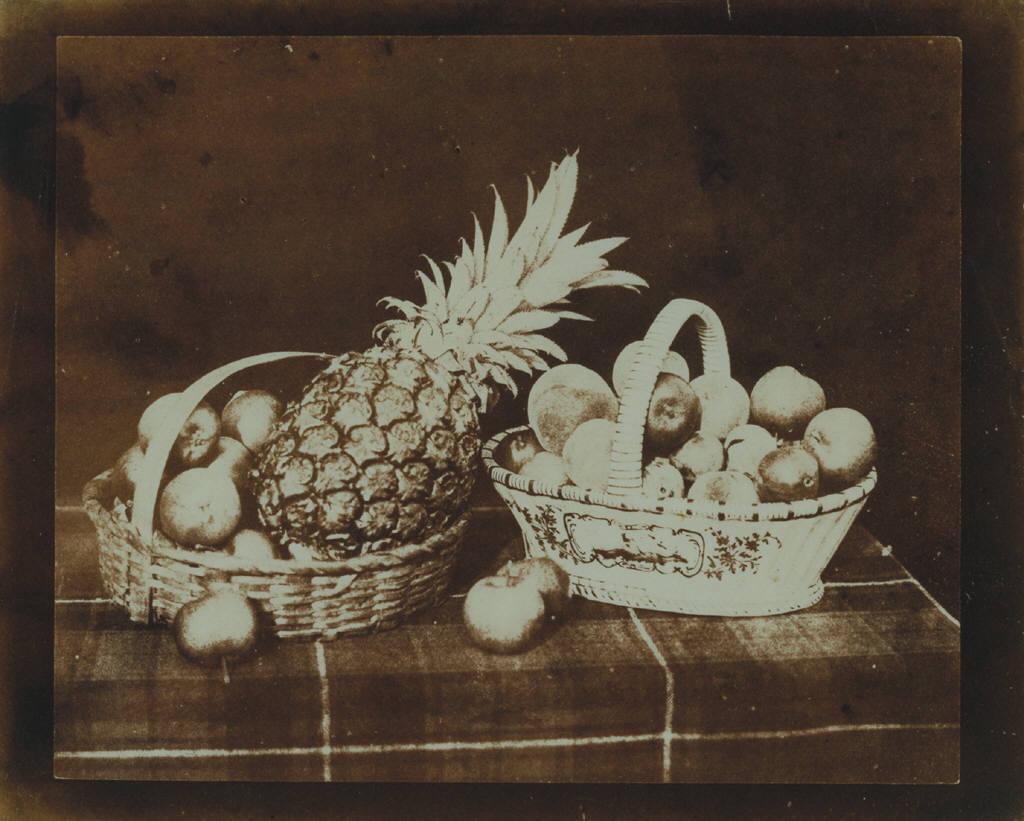
In the early days of photography long exposures were required to take a picture. Still life made an ideal subject because the inanimate objects did not move during the process. William Henry Fox Talbot included a traditional still life composition in his early photographically illustrated publication, The Pencil of Nature (1844–46). Talbot was highly educated and would have been aware of the vanitas themes traditionally associated with still life compositions, though he does not refer to them in the text accompanying A Fruit Piece (above). Instead he discusses technical issues, and explains how the stability or longevity of the photographic image depended upon the correct treatment of the chemicals used to create the photograph. But perhaps this was itself a subtle reference to the shortness of life; as Talbot explained, if the photographer does not take care at every stage then his photographs will fade away…
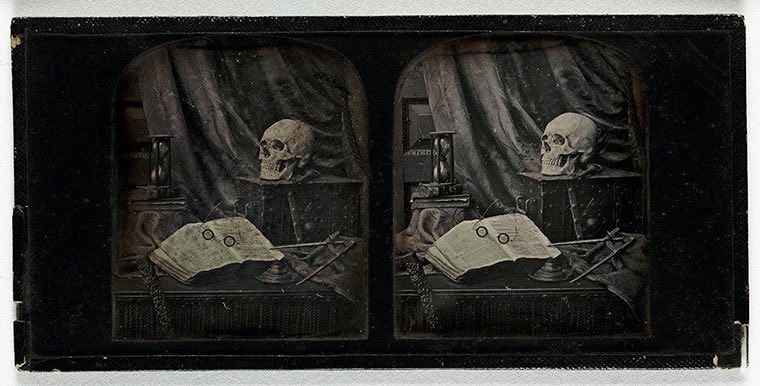
Stereo photographs were popular in Victorian parlours. Although the objects in T. R. Williams’ The Sands of Time (above) were traditionally used to convey vanitas themes, perhaps in this instance they are not meant to be taken so seriously. The references to still life conventions may simply be there to flatter the viewer who understands them. The skull is an overt reference to death and the large book, probably a Bible, lends the composition a religious tone. The compass-like divider calliper is similar to the instrument God was often depicted with, in medieval manuscript illuminations, while in the act of creating the universe. The most overt reference to the shortness of life is the hourglass. Its presence implies that the sands of time will run out for us all. However, because one of stereo photography’s main uses was entertainment, perhaps this still life is not meant to be a moral lesson. It is likely the rendering of such meaningful objects in three dimensions was simply meant to give the viewer a vicarious thrill, and demonstrate Williams’ mastery of his craft.
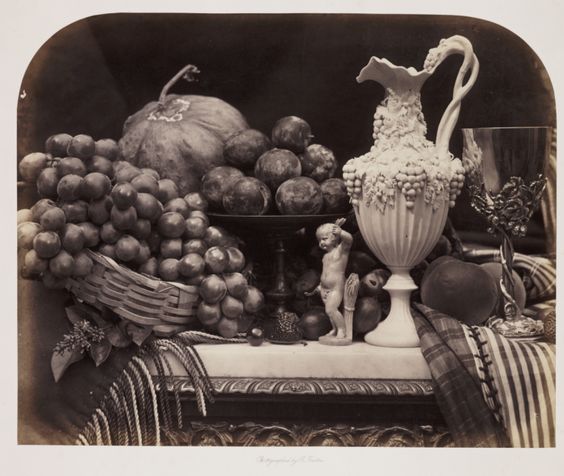
At the same time other photographers were making serious use of the rich symbolism of the still life tradition to add depth and complexity to their work. Roger Fenton’s still life photographs from this period are among the finest ever taken. Previously he had been commissioned to photograph items from the collections of the British Museum. This, combined with the poor weather of 1860, is perhaps why Fenton left his landscape photography and turned to still life photography. In this period, artificial light was too weak for interior photography, so a source of bright natural light would have been essential in the studio. In Still Life with Parian Vase, Grapes and Silver Cup (above) you can see the crisp shadows and intense highlights created by strong sunlight.

On first impression Fenton’s sumptuous still lifes are simply decorative arrangements—a tour de force of shape, tone and texture. Although devoid of overt religious symbolism it is still possible to interpret them as allegories on the meaning of life. Look closely at his Still Life with Ivory Tankard and Fruit (above) and you will see that the vegetables are beginning to show signs of ageing and decay. The grape skins are beginning to wrinkle, while the flowers will soon fade and their petals will drop. Perhaps most intriguing is the upset tankard (with cherubs on the outside occupied in wine-making) which lies on its side to form a black hole at the very centre of the composition. This empty void at the heart of the photograph is an ingenious vanitas motif, which reminds the viewer of death, and the futility of life when lived only for its own sake.
By the first half of the 20th century the academic hierarchy of genres had dissolved, and photography had diversified. However, still life photography experienced a revival with the advent of colour photography, simply because fruit and flowers were a perfect subject to be vibrantly rendered in the new colour photographic processes. As such, they tended to be exercises in depicting different colours, surface textures, and shapes without the heavy symbolism of earlier still life photographs. In the 20th century the still life photograph found a new home in advertising. Commercial photographers, advertising firms and their clients all realised the still life was an ideal vehicle for product promotion. The advertised product is incorporated into a decorative composition of inanimate objects, perhaps arranged in a simulacrum of a Dutch still life painting. The implied domestic setting visually references where the product is destined and also harks back to still life’s lowly status at the bottom of the hierarchy of genres. Partly this is because the still life advertisement photograph works instantly and visually—not on an intellectual level, but also because it is a commercial piece rather than a work of art.

Madame Yevonde was a master of the still life advertising photograph and incorporated odd and unusual elements into her compositions. Here, the rather bizarre juxtaposition of elements show the influence of Surrealism. The above photograph was taken in 1939 for Glyco-Thymoline mouthwash. It refers to the impending war by including bandages, anti gas ointment and a helmet. The owl is symbolic of wisdom.
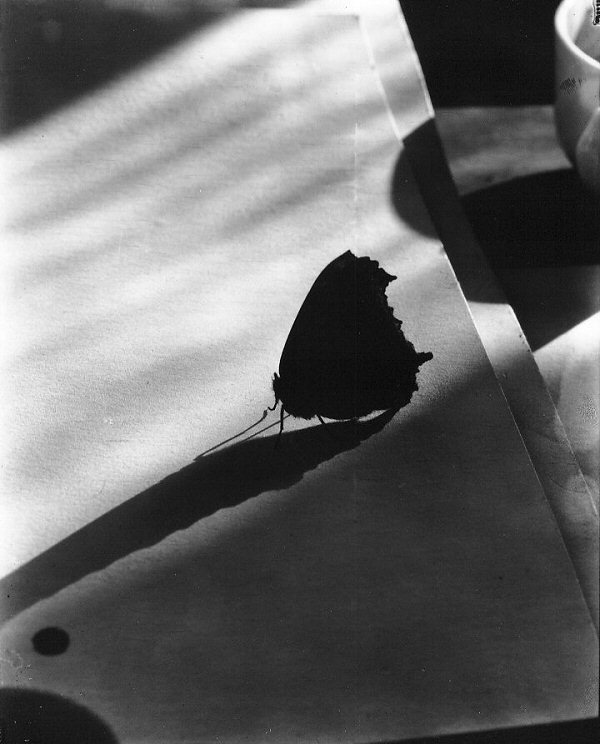
Edward Steichen took Diagram of Doom 2 (above) during a period of personal and professional transition a few years after the end of World War One. Steichen said he: ‘began to reason that, if it was possible to photograph objects in a way that makes them suggest something entirely different, perhaps it would be possible to give abstract meanings to very literal photographs.’ The butterfly is a classic still life motif. Favoured for their beauty, butterflies lead short lives. Often depicted resting on a flower, or piece of fruit, they once again remind the viewer not to place too much emphasis on temporal or physical things, but instead to look towards long term spiritual ends. Steichen further emphasises this vanitas interpretation by photographing the butterfly at the end of the day, when shadows are elongated, enhancing the notion that our time on earth is running out.
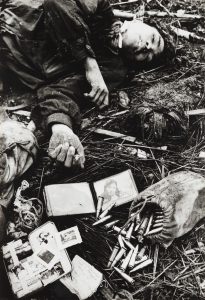
Today, still life photography is rarely practised in its pure, traditional form. However, an understanding of still life conventions provide strategies for reading an image. This can reveal layers of meaning that are otherwise hidden, and help explain the pathos, poignancy or power of an image. One example is Don McCullin’s Dead North Vietnamese Soldier and His Plundered Belongings, Hue (above). This graphic image, taken by a photojournalist in a war zone, would rarely be considered a still life image, but it shares common qualities with the genre. This is the only image where McCullin admits to having moved objects before taking the photograph. He gathered the dead soldier’s scattered belongings and placed them near his body, therefore making conscious arrangement of inanimate objects for a desired effect. This photograph is a brutal depiction of death, and about reclaiming the humanity of the man we see surrounded by his belongings. He is slightly out of focus, which makes him look as if he might be asleep. But the objects in the foreground, rendered in sharp focus, make the true meaning of this image impossible to miss.
So far this essay has concentrated on morbid rather than decorative aspects of the still life. But perhaps there is a more optimistic interpretation to traditional still life motifs. Consider the Roman Stoic philosopher, Seneca, who wrote:
It is not that we have a short life, but that we waste a lot of it. Life is long enough, and a sufficiently generous amount has been given to us for the highest achievements if it were all well invested. But when it is wasted in heedless luxury and spent on no good activity, we are forced at last by death’s final constraint to realize it has passed away before we knew it was passing. So it is: we are not given a short life but we make it short, and we are not ill-supplied but wasteful of it. Just as when ample and princely wealth falls to a bad owner it is squandered in a moment, but wealth however modest, if entrusted to a good custodian, increases with use, so our lifetime extends amply if you manage it properly.
—Seneca, On the Shortness of Life, c.AD65
As well as the importance of morality, Seneca gives an insight into the art of living, and perhaps this is what the contemporary viewer should consider when using 17th century still life conventions to interpret a recent or modern work. Yes, life is fleeting when compared to universals, but this only makes it all the more precious.
Why be saddled with this thing called life expectancy? Of what relevance to an individual is such a statistic? Am I to concern myself with an allotment of days I never had and was never promised? Must I check off each day of my life as if I am subtracting from this imaginary hoard? No, on the contrary, I will add each day of my life to my treasure of days lived. And with each day, my treasure will grow, not diminish.
—Robert Brault, 2011
One comment on “‘Art of Arrangement’: On the shortness of life”